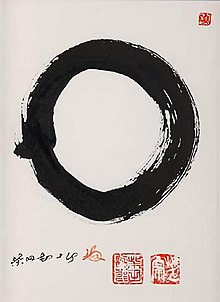| This article needs additional citations for verification. Please help improve this article by adding citations to reliable sources. Unsourced material may be challenged and removed. Find sources: "Ensō" – news · newspapers · books · scholar · JSTOR (February 2017) (Learn how and when to remove this message) |

In Zen art, an ensō (円相, "circular form") is a circle hand-drawn in one or two uninhibited brushstrokes to express the Zen mind, which is associated with enlightenment, emptiness, freedom, and the state of no-mind.
Description
The ensō symbolizes absolute enlightenment, strength, elegance, the universe (Dharmadhatu), and mu (emptiness). It is characterised by a minimalism influenced by Zen Buddhist philosophy, and Japanese aesthetics. An empty circle also appears in the ten oxherding pictures which is a set of illustrations that depict Zen training.
Drawing ensō is a disciplined-creative practice of Japanese ink painting, sumi-e. The tools and mechanics of drawing the ensō are the same as those used in traditional Japanese calligraphy: One uses an ink brush to apply ink to washi (a thin Japanese paper).
The circle may be open or closed. In the former case, the circle is incomplete, allowing for movement and development and the perfection of all things. Zen practitioners relate the idea to wabi-sabi, the beauty of imperfection. The space inside the circle may represent the state of the realization of emptiness (shunyata) or no-mind.
Usually, a person draws the ensō in one fluid, expressive stroke. When drawn according to the sōsho (cursive) style of Japanese calligraphy, the brushstroke is especially swift. Once the ensō is drawn, one does not change it. It evidences the character of its creator and the context of its creation in a brief, continuous period. Drawing ensō is a spiritual practice that one might perform as often as once per day.
This spiritual practice of drawing ensō or writing Japanese calligraphy for self-realization is called hitsuzendō. Ensō exemplifies the various dimensions of the Japanese wabi-sabi perspective and aesthetic: fukinsei (asymmetry, irregularity), kanso (simplicity), koko (basic; weathered), shizen (without pretense; natural), yugen (subtly profound grace), datsuzoku (freedom), and seijaku (tranquility).
See also
- Abstract expressionism, a 20th-century American art movement
- Buddhism in Japan
- Dhyāna in Buddhism, a meditation practice in which the observer detaches from several qualities of the mind
- Ink wash painting, an East Asian style of brush painting that uses black ink
- Ouroboros, an ancient symbol depicting a serpent or dragon eating its tail
- Wuji
References
- Tanahashi, Kazuaki (2013). Treasury of the True Dharma Eye. Shambhala. p. 1115. ISBN 978-0-8348-2836-0.
圓相 , literally, circle form. Represents enlightenment. 團圝 , literally, circle round. Represents intimacy.
- Seo, Audrey Yoshiko (2007). Ensō: Zen Circles of Enlightenment. Boston: Weatherhill. ISBN 9780834805750. OCLC 71329980.
Further reading
- Seo, Audrey Yoshiko; Addiss, Stephen (1998). The Art of Twentieth-century Zen: Paintings and Calligraphy by Japanese Masters. Boston: Shambhala Publications. ISBN 9781570623585. OCLC 39108653.
| Japanese social concepts and values | |||||
|---|---|---|---|---|---|
| Sociocultural values |
| ||||
| Aesthetics | |||||
| Etiquette and social norms | |||||
| Types of people |
| ||||
| Work culture | |||||